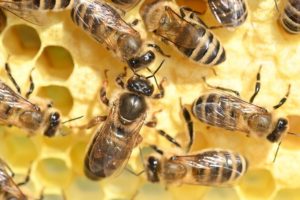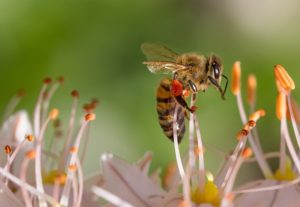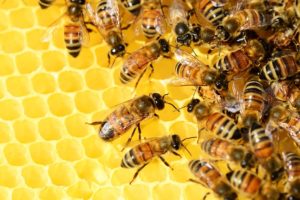Queen Bees – An Overview
Queen bees are at the core of the beehive, but that doesn’t mean they don’t rely on other bees, or that they can’t be replaced. A healthy, happy queen means the other bees are happy, and that the hive continues to thrive with new bees. These buzzing monarchs are more than meets the eye.
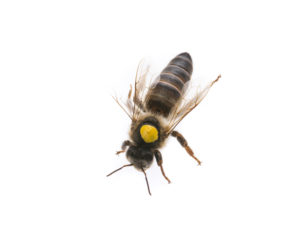
What are Queen Bees?
Queen bees are the main concern of the entire hive, although there’s only ever one true queen within the colony. The queen is the only female bee capable of reproducing, and she does this throughout the majority of her lifespan. She doesn’t maintain the hive, tend to young bees, or gather food. She simply ensures the hive continues by laying eggs that make up the next generations of bees. That said, laying eggs isn’t the only way she helps the hive. The queen produces pheromones, which only her hive can smell. These pheromones prevent female worker bees from reproducing, and generally keep the hive calm and productive.
Lifespan of the Queen Bee
Workers bees only live for about 60 days at most, in the summer. However, switching queens this frequently would make it difficult for a hive to succeed. Queens live far longer than any other bee in the colony, and typically live several years. Queens can live anywhere from two to five years, and sometimes even longer.
Special, larger cells are reserved for potential queens, selected by the workers. These initial, larger cells are called queen cups. Once the current queen lays a fertilized egg in a queen cup, worker bees start adding to the construction to create a queen cell for the larval queen. Workers select potential queens by feeding them royal jelly, produced from glands of worker bees. Larvae destined to be workers are primarily fed bee bread, which is made of pollen and nectar.
Then, worker bees continue raising the young queen until she’s ready to leave her wax cell. Once she emerges, she’s known as a virgin queen.
Virgin Queen
Virgin queens are much what they sound like- queen bees that have yet to mate with any drone. However, life is far from easy for virgin queens. Those that emerge from their cells first have the greatest advantage. Other virgins queens might not even get the opportunity to come out of their queen cells. There’s more than one virgin queen, and it’s a constant fight until only one remains. The virgin queens search out their competition and try to eliminate all the others. They don’t stop at the bees that have gotten out of their cells, either. They’ll also chew into queens cells to get rid of other potential queens.
Virgin queens do have one advantage, however. Because they don’t yet produce the levels of pheromone that a regular queen does, they’re more readily accepted into a hive without a queen. Queens that have mated secrete a stronger pheromone, which is unique to their hive. If they’re put into another hive, even one without a queen, the hive typically rejects them. That’s because the unique pheromone helps a queen’s hive to identify her. Other hives will see her as a stranger or possibly even an intruder.
A surviving virgin queen may either leave the hive with the main swarm, or the after-swarm. While the main swarm will only have one virgin queen (and even a mated queen) other virgin queens can either remain with the rest of the hive, or go with the afterswarm. No matter the case, the virgin queens continue to fight for dominance until only one survives.
Mated Queens
Before a colony accepts her as their true queen, she has to mate with the drones. Virgin queens typically mate around a week after they leave their queens cells (or 6-10 days after). This happens in a very specific location, known as the congregation area, or drone congregation area. At no other time in her life will the queen mate with drones. The queen bee doesn’t have long to mate, either. If she’s lucky, she might have a few days. While there are hundreds of drones in a colony, queen bees might only mate with up to 15 in a single day.
Mated queens use a special organ, called the spermatheca, to store all the sperm they gather in these few days. Because mating happens during flight, bees need specific weather conditions and altitudes to be successful. Unseasonably poor weather can ultimately cause an entire colony to die off. Queens can lay up to 2,000 eggs every day, so successful mating is crucial to the hive’s survival. Remember that worker bees and drones only live around 6-8 weeks during the summer, and slightly longer during the winter.
If a queen can’t gather enough sperm to continue fertilizing eggs, she can only lay eggs that grow into drone bees. Drones don’t do the work of the other bees, and eventually, the hive will die.
You can see why having a successfully mated queen is important to the entire hive. As long as the queen has enough sperm stored, she can continue the line of worker bees for many, many years. Worker bees tend to the mated queen devotedly, as long as she keeps laying eggs and secreting her pheromones.
Aging Queens
In their prime, queen bees lay plenty of eggs to keep her hive healthy and thriving. However, she also releases a special pheromone that her hive recognizes. The pheronome shows the hive that their queen is healthy and well, and keeps the other bees reassured. Unfortunately for the queen bee, she won’t always produce the same amount of the pheromone. Aging queens produce less pheromones, and less eggs. These are the first signals to worker bees that they need to prepare for a new queen. Worker bees constantly tend to the queen, and they notice when her egg laying diminishes.
A colony can’t go without a queen, and the workers begin the process of supercedure, wherein they start preparing potential new queens. These new queens start the entire cycle over again as virgin queens. In certain instances, the older queens are allowed to live. However, sometimes workers neglect the current queen in favor of the new one, and the older queen eventually dies. In one of the more extreme methods of getting rid of a queen, workers resort to balling. Workers form tight groups around the old queen until she eventually dies of overheating.
Replacing Queen Bees
When it’s evident a queen is aging out of her productive lifespan, workers prepare new queens. However, not every replacement is quite this easy for bees to prepare for. When a queen ages naturally, workers can feed the potential queen larvae royal jelly and allow them to emerge in their own time.
When a queen unexpectedly dies, the workers have to prepare for an emergency queen. Workers go through brood cells with female larvae that are just coming from their cells. They then start a diet of royal jelly by filling the cells with it. Workers jump start the queen replacement process by taking the regular, worker cell, and creating a new queen cell over it.
Queens created through emergency replacement don’t typically produce as many eggs as a queen designated from the start. They also tend to be smaller than your typical queen bee.
How do Beekeepers get Queen Bees?
There are plenty of different ways to introduce a queen bee to a colony. However, it’s difficult for a mated queen to enter an existing colony, whether it’s in nature or in an apiary. Beekeepers can either raise fertilized larvae (female), or purchase a queen bee.
If beekeepers plan on queen rearing themselves, they need the proper larvae, and some small colonies. Typically, the larvae go into special queen cells, which beekeepers then put into a designated colony (often called a cell building colony). These colonies contain no queen, but rather many bees that will go on to raise the potential queens and feed them with royal jelly.
Once the larvae mature more, the beekeeper takes them to special mating colonies. After the virgin queens come out of their cells they have around a week before they begin mating. They then return to their original mating colony as the one mated queen.
However, there are many different ways to get a queen bee, and this is just one of the more common methods.
When a queen stops producing sufficient eggs, beekeepers can also begin the replacement process early. This is also called requeening. Beekeepers may not keep their queen bees for their entire lifespan, and can instead choose to requeen every couple of years, or even every year.
Identifying Queen Bees
Queen bees often stand out from the rest of the colony, although with so many bees in a hive, it can be hard to set them apart right away. First, queens bees are around twice the size of worker bees. However, drones are also much larger than worker bees. The queen’s abdomen is longer than a drone’s and also a worker’s. If you only had a few bees to look at, finding a queen would be easy.
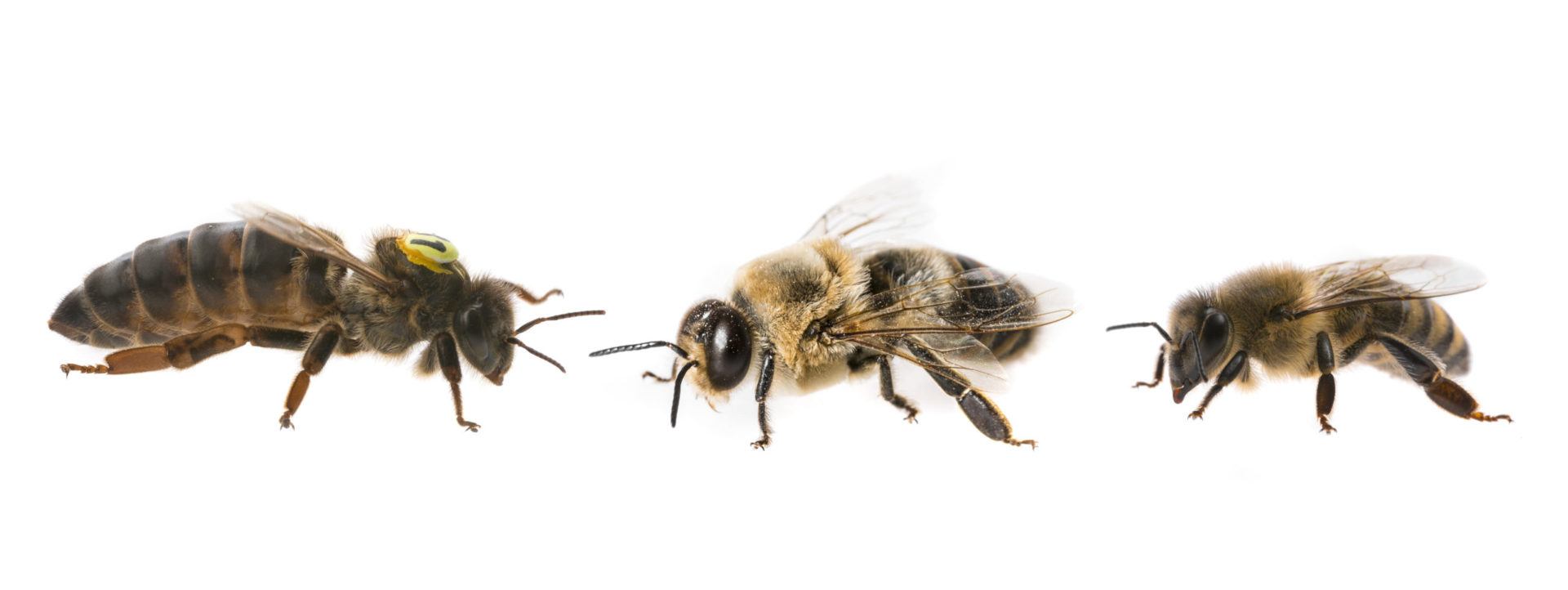
When you’re looking at thousands of bees however, it’s nowhere near that quick or easy. The best way for most beekeepers to keep track of their queens is with a tiny dot of paint. They put the paint (ideally, bright colored for quick identification) on the queen’s thorax so they can find her. The paint shouldn’t bother the bees, or affect the queen’s productivity.
Some beekeepers use the paint color as an indication of the queen’s age (or rather, the year introduced to the colony). However, this is more common in larger apiaries, and smaller operations often use any color to identify their queen or queens.
